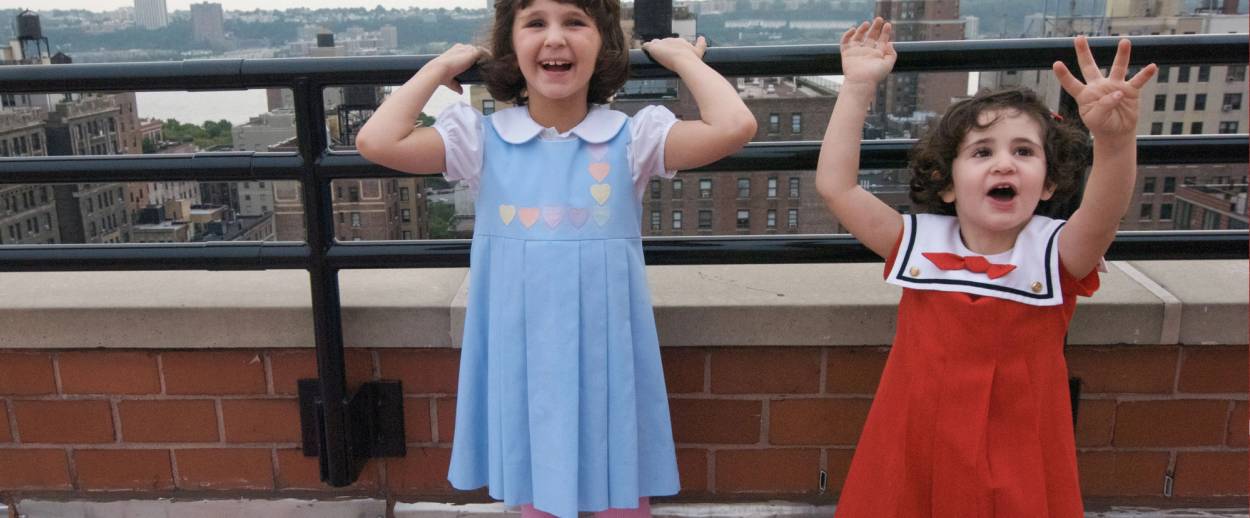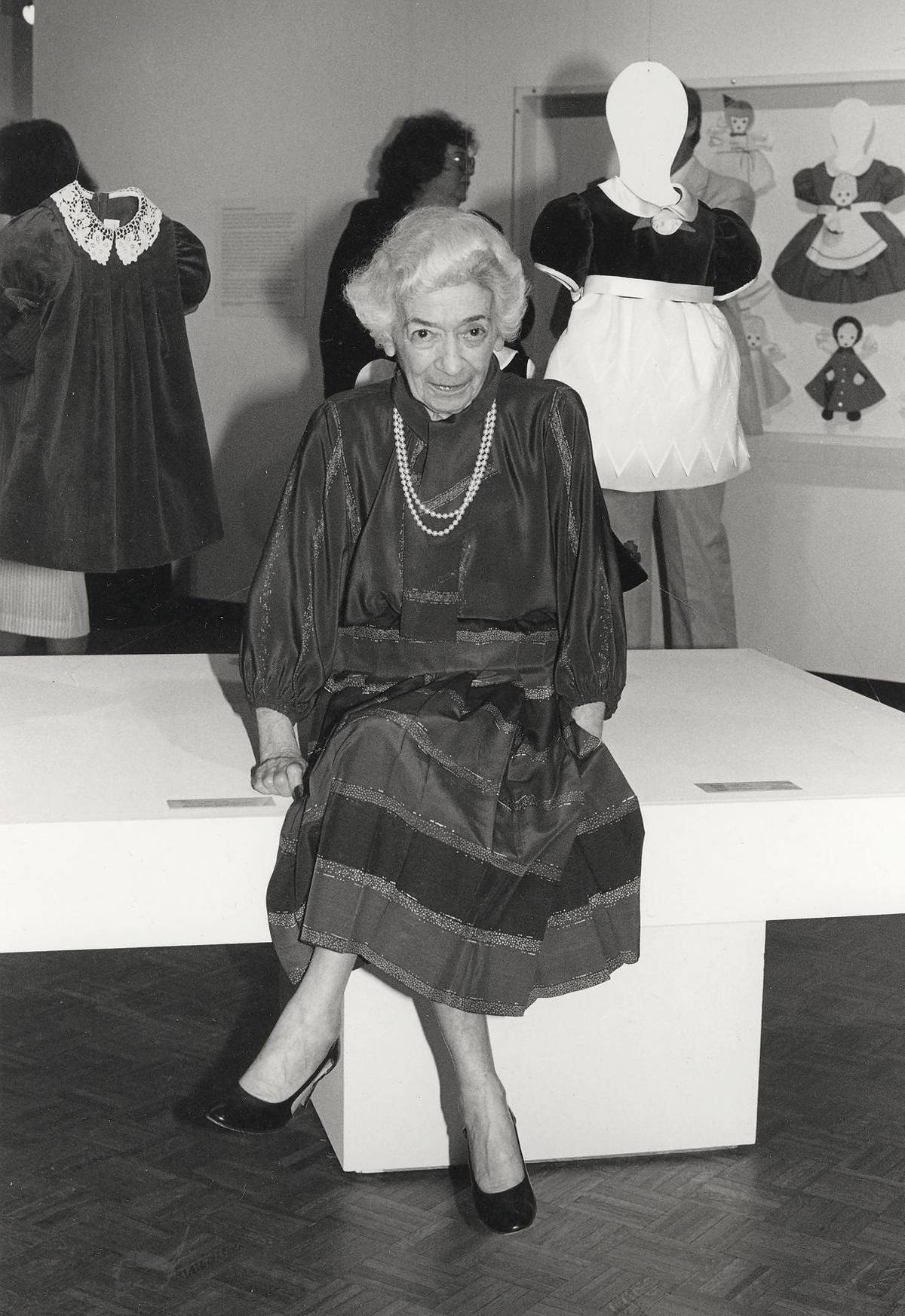Keeping Kids in Fashion
Florence Eiseman launched her distinctive line of children’s clothes 70 years ago




I first learned about Florence Eiseman from my mother-in-law in Milwaukee. There, Eiseman is as famous as Miller Beer, Harley-Davidson, Laverne & Shirley, and the Violent Femmes.
Florence Eiseman was a designer of children’s clothes. Her career began 70 years ago, in 1945, when her husband Laurence’s toy factory was struggling. Florence was well-known in the Jewish community for her sewing skills—she’d taken up needlework in the 1930s on the advice of her doctor, as a cure for “nerves”—so Laurence gathered up some of the children’s pinafores she’d made at home and took them to a buyer at Marshall Field’s department store. The store placed an order for $3,000. (The couple’s son Laurie later said that his father went straight to Marshall Field’s fabric department and used all the money to buy organdy.) Soon the Eisemans had plenty of orders, with Florence farming out sewing work to other Milwaukee Jewish matrons. But the company took a while to find its footing. In a 1982 profile in People magazine, she said, “I used to tell my husband, ‘When are we going to make money? We can’t eat organdy.’ ”

Eventually, the business took off. Parents loved the label’s classic, playful designs and superior workmanship. “Eisemans” were made of high-quality, natural fabrics, with elegant-but-still-childlike designs and intricate stitching. At a time when kids were swathed in ruffles and petticoats, Eiseman offered a more streamlined silhouette. The wee spawn of Princess Grace of Monaco, Elizabeth Taylor, and multiple Kennedys, Rockefellers, and Fords all wore her clothing. In 1955, she became the first childrenswear designer to win the international Nieman Marcus Award for contributions to fashion. (Other winners have included Elsa Schiaparelli, Christian Dior, Emilio Pucci, Coco Chanel, Yves Saint Laurent, Ralph Lauren, Missoni, Mary McFadden, Karl Lagerfeld, Issey Miyake, and Miuccia Prada.) In 1984, she became the first children’s fashion designer honored with a career retrospective in an art museum. (It was at the Denver Art Museum; the Milwaukee Journal’s art critic, James Auer, covered it, noting breathlessly that Eiseman’s work was known for “the so-called A-line, in which the garment hangs directly from the shoulder, a style Eiseman featured in advance of Givenchy.”) In 1985, the Milwaukee Art Museum held a retrospective of her work.
Eiseman became a collector of modern art, covering the walls of her home on Milwaukee’s East Side with works by Picasso, Dubuffet, Matisse, and Kandinsky; a Calder mobile hung from her living room ceiling. She created collections inspired by Renoir’s Girl With a Watering Can, Picasso’s Saltimbanque series, and Mondrian’s primary-colored rectangular graphics.
***
My mother-in-law Betsy never owned an Eiseman herself, but she got to wear one while strutting the runway for a synagogue fashion show in 1947 or ’48. “I modeled a black velvet jumper,” she recalled to me recently on the phone. “My mother absolutely loved it, but my dad had only been in [medical] practice for a few years, and it was so expensive so he wouldn’t let her buy it.” (Betsy wound up getting a dress from one of Eiseman’s home-sewers instead.)
By the time my sister-in-law Ellen was born in the ’70s, Eiseman was an industry, with dresses selling for up to a hundred bucks a pop. (In the ’80s, some cost nearly $300.) Betsy and her friend Diane would make twice-annual pilgrimages to the famous Eiseman sample sales in Fond du Lac, Wisconsin. “We couldn’t afford it if it weren’t on sale!” she told me. “But the sales were fabulous—tons of beautiful things just thrown on tables. You could fill your whole car for $200. I loved the simplicity of the designs, the elegance, the fabrics. The family used to go to France and Italy and Switzerland to get fabrics. Ellen had a navy blue Eton jacket with little red applique hearts on it. After Ellen wore it, [her second husband’s granddaughter] Lauren wore it, then Josie wore it, then Max wore it and maybe one day [my 2-year-old niece] Lucy will wear it, too. They used to make what they called ‘well-mannered knits’ that washed so well. Little cotton Peter-Pan-collared shirts and pleated skirts. Oh, Ellen looked adorable!”

To my own surprise, I swooned over the old-fashioned but still hip little outfits Betsy handed down to me, carefully folded in tissue paper. Eisemans were known for their primary-colored heart and minimalist flower and watermelon-slice-with-seeds appliques. The cottons were soft and comfortable—my sensory-issues-troubled Maxine could happily wear them, pronouncing them “not itchy,” even after 25 years in storage. Nothing pinched or was tight at the waist. “Little children,” Eiseman told People firmly, “don’t have waistlines. They have protruding tummies.” The clothes made kids look like kids.
Eiseman, born Florence Feinberg, kept designing into her 80s. She was only 4’10” and 75 pounds, but she was a powerhouse, issuing big Vreeland-esque pronouncements like “The biggest mistake mothers make is to dress boys to look like little men. There is nothing worse, except possibly fur coats on little girls.”
After her death in 1988 (Laurence had died in 1967), the company’s magic faded. Eiseman’s sons sold the business in 1989, and the new owner cut costs (and according to fans, quality) relentlessly. Customers and retailers fled in droves. In 1993, the company changed hands again, and production was moved from Wisconsin to Colombia. Quality and sales improved … but the company was still spending too much money. So Eiseman’s sons—by then in their 70s, retired, and volunteering with the local art museum, ballet, and tutoring programs at Milwaukee’s inner city schools—decided to return. In 1999 they created a new partnership and bought back their mother’s company, slashing staff and retaining production facilities overseas.
As far as I can tell, the company’s doing OK. Earnings approximate what they were in the past (in the neighborhood of $7 million a year—it was always a niche label). There are now three different lines (Studio 342 for trendy tween girls; T.F. Laurence for boys who want to look like prematurely ruddy-faced yacht owners; and the classic Florence Eiseman, which still has flashes of the original label’s flair—check out Suri Cruise). All three cost more than I want to spend on my filthy, destructive, annoyingly-fast-growing children’s wardrobe. But the original Florence Eiseman label sells at by far the highest price point and is the only one I think embraces the company’s history and charm.
The clothes are back in upscale department stores and boutiques. Prices at Neiman Marcus top out at a nosebleed-inducing $228 for a girls’ red velvet A-line party dress; at Saks, pair of blue-and-white seersucker shortalls for a baby with appliques of a crab grabbing one of the buttons (so cute!) and tiny fish at the hem is $78, and a classic navy cotton corduroy A-line dress with an applique of an apple on it is on sale for $61.50.
Josie has aged out of all but the Studio 342 clothes, at which she turns up her emo anti-corporate nose. Maxie was content to be my little mannequin for far longer than her sister—for her, comfort trumped all else. So, I checked eBay every day for vintage Eisemans, sometimes sending links (with virtual email cooing sounds) to my mother-in-law. Even seeing the classic label, with Florence Eiseman’s signature in slanting, assertive Parker penmanship, makes me happy. But now Maxie, too, has opinions, damn her, and she just informed me that the winsome vintage green apple sweater-dress I’ve been eyeing for weeks is “ugly as sin” and “looks like an old lady dress.” (Apparently the youth of today agree with her, because the seller has relisted it twice with no takers.) The baby and toddler sizes, at least, get snapped up as soon as they hit the auction site. I have to sublimate my Eiseman jones by admiring old pictures of my kids in their Milwaukee-grown finery. Sic transit gloria Florie.
***
Like this article? Sign up for our Daily Digest to get Tablet Magazine’s new content in your inbox each morning.
Marjorie Ingall is a former columnist for Tablet, the author of Mamaleh Knows Best, and a frequent contributor to the New York Times Book Review.